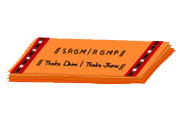Posted By: Administrator
Rāga: Dhhanaśhrī
Thāḷa: Ādhi
Composer: Swāthi Thiruṇāḷ
Language: Hindi
Pallavi:
Githa dhuniki thaka thai nādhru dhru dhru thām nācharahe gori thām dhithai thai dhithai dhirahata
(Githa dhuniki)
Anupallavi:
Bāja pāyal karo jhhanana jhhanana
Bāja pāyal karo jhhanana jhhanana thanana thanana thom jhhanana jhhanana thanana thanana thom
jhhanana jhhanana thanana thanana (Githa dhuniki)
Charaṇam 1:
Th ān gāve thakatha thai thathai
Thaittha thaittha thakata ṇam dhīm thakiṭathakadhīm dhīm thakiṭathakadhīm dhīm thakiṭathakadhīm
Tryaka thom tryaka thom tryaka (Githa dhuniki)
Charaṇam 2:
Padhumanābha thumhāri lilā kyā karū mei sāvaro
thāpa saṅkaṭa haraṇe āyo so hamāro thum haro
(Chiṭṭasvara)
Thadhīm thadhīm dhiranā udanitha thāni thāni thadhīm thadhīm dhiranā
Thādhiththām thathara alari thathom thadhimi thānidhīm alari alari
Thathara thām thāni thadhimi thām thāni takiṭa thām thāni dhīm dhīm dhīm thari
Alari thām thām thām thakadhimi alari thom thom thom thakadhikithaka alari
(Githa dhuniki)
Meaning:
Pallavi:
Nācharahe gori thām dhithai thai dhithai dhirahata
nācharahe - is dancing
gori - the girl
thām dhithai thai dhithai - beats of the dance.
The girl dances to the beats of thām dhithai thai dhithai and others.
Anupallavi:
Bāja pāyal karo jhhanana jhhanana
Bāja - to sound
Pāyal - anklet
Karo - to do (does)
jhhanana jhhanana - sounds of the anklet
The anklet makes the sound, jhhanana jhhanana.
Charaṇam 1:
Th ān gāve thakatha thai thathai
Th ān - the verse
gāve - sings
thakatha thai thathai - the syllables of the verse
The syllables of the verse go - thakatha thai thathai.
Charaṇam 2:
Padhumanābha thumhāri līlā kyā karū mei sāvaro
thāpa saṅkaṭa haraṇe āyo so hamāro thum haro
Padhumanābha - one who has a lotus navel
thumhāri - your
līlā - sport of the God
kyā - what
karū - to do
mei - I
sāvaro - a name for Kriṣhṇa
thāpa saṅkaṭa - the problems
haraṇe - to solve
āyo so - as you come
hamāro - ours
thum - you
haro - defeat
O lord with the lotus navel, how do I explain your sport? As you come, you defeat all our problems.












